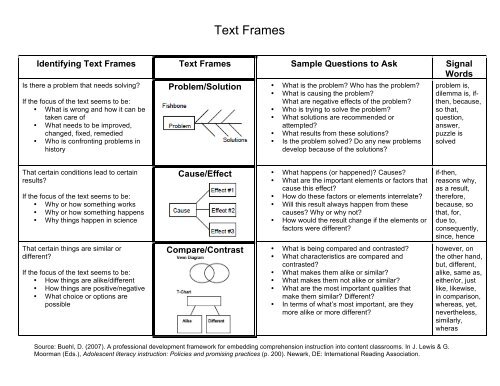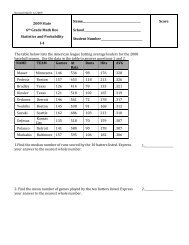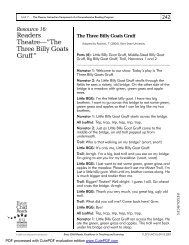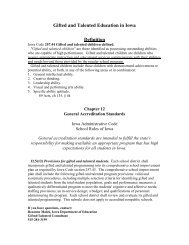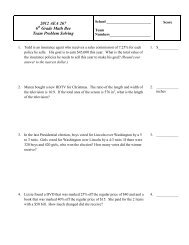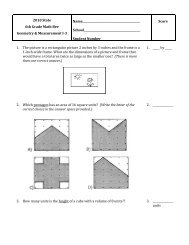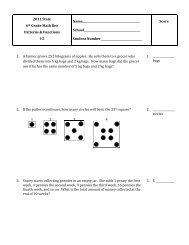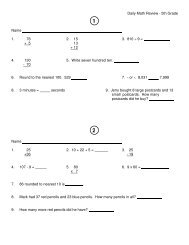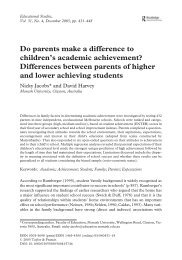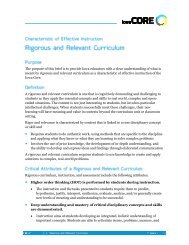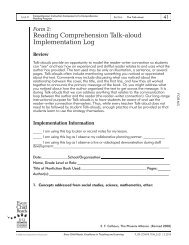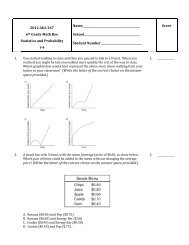Session 1 Text Frames - Aea 267
Session 1 Text Frames - Aea 267
Session 1 Text Frames - Aea 267
- No tags were found...
You also want an ePaper? Increase the reach of your titles
YUMPU automatically turns print PDFs into web optimized ePapers that Google loves.
<strong>Text</strong> <strong>Frames</strong>Identifying <strong>Text</strong> <strong>Frames</strong> <strong>Text</strong> <strong>Frames</strong> Sample Questions to Ask SignalWordsIs there a problem that needs solving?If the focus of the text seems to be:• What is wrong and how it can betaken care of• What needs to be improved,changed, fixed, remedied• Who is confronting problems inhistoryProblem/Solution • What is the problem? Who has the problem?• What is causing the problem?What are negative effects of the problem?• Who is trying to solve the problem?• What solutions are recommended orattempted?• What results from these solutions?• Is the problem solved? Do any new problemsdevelop because of the solutions?problem is,dilemma is, ifthen,because,so that,question,answer,puzzle issolvedThat certain conditions lead to certainresults?If the focus of the text seems to be:• Why or how something works• Why or how something happens• Why things happen in scienceThat certain things are similar ordifferent?If the focus of the text seems to be:• How things are alike/different• How things are positive/negative• What choice or options arepossibleCause/Effect • What happens (or happened)? Causes?• What are the important elements or factors thatcause this effect?• How do these factors or elements interrelate?• Will this result always happen from thesecauses? Why or why not?• How would the result change if the elements orfactors were different?Compare/Contrast • What is being compared and contrasted?• What characteristics are compared andcontrasted?• What makes them alike or similar?• What makes them not alike or similar?• What are the most important qualities thatmake them similar? Different?• In terms of what’s most important, are theymore alike or more different?if-then,reasons why,as a result,therefore,because, sothat, for,due to,consequently,since, hencehowever, onthe other hand,but, different,alike, same as,either/or, justlike, likewise,in comparison,whereas, yet,nevertheless,similarly,wherasSource: Buehl, D. (2007). A professional development framework for embedding comprehension instruction into content classrooms. In J. Lewis & G.Moorman (Eds.), Adolescent literacy instruction: Policies and promising practices (p. 200). Newark, DE: International Reading Association.
<strong>Text</strong> <strong>Frames</strong>That someone is doing something for aspecific reason?If the focus of the text seems to be:• Who is trying to do something• How to do something• What steps, directions, orprocedures to followThat a concept needs to be understood?If the focus of the text seems to be:• What something is or looks like• How something can be described• How something can be classifiedThat a viewpoint is being argued andsupported?If the focus of the text seems to be:• Why accept an opinion,hypothesis, theory, or argument• What viewpoint is expressed in areview, editorial, persuasion, orappeal• How conclusions are based onresearch results or studiesGoal/Action/Outcome • What is the goal? What is to be accomplished?• Who is trying to achieve this goal?• What actions/steps are taken to achieve thisgoal?• Is the sequence of actions/steps important?• What are the effects of these actions? Whathappens?• Were these actions successful for achievingthe goal?• Are there unexpected outcomes from theseactions?• Would other actions have been more effective?Could something else have been done?Concept/Definition • What is the concept?• What category of things does this conceptbelong to?What are its critical characteristics?• How does it work? What does it do?• What are its functions?• What are examples of it?• What are examples of things that share somebut not all of its characteristics?Proposition/Support • What is the general topic or issue?• What viewpoint, conclusion, theory, hypothesis,or thesis is being proposed?• How is this proposition supported?• Are examples/data provided to support theproposition?• Is expert verification provided to support theproposition? Logical argument?• Does the author make a convincing case forthe proposition?• What are alternative perspectives to theauthor’s proposition?as a result of,first, second,third, then,after, while,meanwhile,finally, at last,in the end,resulting in,affect offor example,characteristics,for instance,such as, is like,including, toillustratefor example,therefore, first,second, third,before, after,then, finally,in conclusionSource: Buehl, D. (2007). A professional development framework for embedding comprehension instruction into content classrooms. In J. Lewis & G.Moorman (Eds.), Adolescent literacy instruction: Policies and promising practices (p. 200). Newark, DE: International Reading Association.
<strong>Text</strong> <strong>Frames</strong>Source: Buehl, D. (2007). A professional development framework for embedding comprehension instruction into content classrooms. In J. Lewis & G.Moorman (Eds.), Adolescent literacy instruction: Policies and promising practices (p. 200). Newark, DE: International Reading Association.


